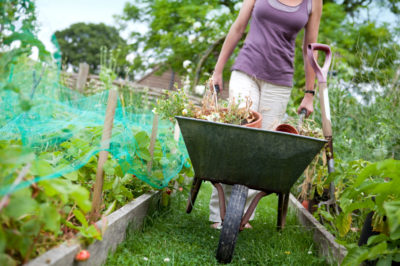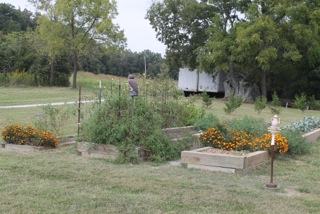 For many years I’ve been a big fan of raised-bed gardening. It wasn’t until recently that I began to grow some of my food directly in the ground without raised beds. Now, I use a mixture of both methods. My corn, beans, squash, zucchini, pepper and watermelon plants are planted directly into the ground, while most of my other veggies like tomatoes, onions, potatoes, and herbs are grown in raised beds.
For many years I’ve been a big fan of raised-bed gardening. It wasn’t until recently that I began to grow some of my food directly in the ground without raised beds. Now, I use a mixture of both methods. My corn, beans, squash, zucchini, pepper and watermelon plants are planted directly into the ground, while most of my other veggies like tomatoes, onions, potatoes, and herbs are grown in raised beds.
There are many benefits to raised bed gardening. Number one on my list is that most raised beds will allow you to grow food in any location. This was how I got started gardening years ago when I lived on a tiny little lot, the size of a postage-stamp size out in the suburbs. City and neighborhood regulations kept me from having a full-fledged garden, but I could have a small raised bed as long as it stayed out of sight in my backyard. So, I had my husband build me a small square-foot garden that blessed our family with tomatoes. The next year I added a small little square-foot herb garden.
Raised beds let you control soil conditions.
With raised-bed gardening, you get to control the soil conditions in your garden. Bad soil? Clay soil that’s hard to break apart? No problem. Simply build your raised bed, amend your soil by bringing better soil, and you’re ready to get growing.
Even better, with raised beds, as a general rule your soil will be less compacted and will also tend to drain away excess water better. And, soil in a raised bed will warm up quicker than the soil in the ground, allowing you to get a small jump on the gardening season. (But don’t expect miracles … even with raised beds you probably won’t be eating tomatoes in April.)
Other great benefits of square-foot gardening:
- Save your back! You don’t have to bend over quite so far with raised beds.
- You can get creative. Make all sorts of shapes and sizes of raised beds to accommodate your preferences and your landscape.
- Weeding is easier as raised beds usually smother out grass and weeds better.
- Pests like gophers and moles aren’t as big of a problem
- You can grow more per square foot and take advantage of your space.
Order your 2015 Heirloom Solutions seed catalog and get $20 in your account!
In the interest of fairness, I have to point out a few downsides to raised bed gardening. Thankfully, there aren’t many.
 The biggest deterrent to raised bed gardening is usually the cost. Lumber is at a premium price right now, and after building a few boxes and filling them up with quality soil, you can easily spend $100 or more. Raised beds must also be replaced from time to time as the lumber wears down. Beds made of redwood will last you approximately 10 years. I did purchase some pre-made raised beds constructed from recycled cardboard and that cost me about $40 for three small beds. These boxes only lasted for three seasons before they were rotten, so I highly encourage you to purchase good quality materials for constructing your beds if at all possible.
The biggest deterrent to raised bed gardening is usually the cost. Lumber is at a premium price right now, and after building a few boxes and filling them up with quality soil, you can easily spend $100 or more. Raised beds must also be replaced from time to time as the lumber wears down. Beds made of redwood will last you approximately 10 years. I did purchase some pre-made raised beds constructed from recycled cardboard and that cost me about $40 for three small beds. These boxes only lasted for three seasons before they were rotten, so I highly encourage you to purchase good quality materials for constructing your beds if at all possible.
A few other points to consider about raised beds:
- You will need to refresh your soil periodically (but any soil needs to be amended from time to time).
- Raised bed gardens do not accommodate large crops like corn or squash very well, but they are perfect for small to medium sized veggie plants.
Before you head off to the store to buy lumber, let’s answer a few frequently asked questions about raised-bed gardening.
- What dimensions should I use? How deep and wide should my raised beds be?
There is no right or wrong answer here. The answer lies in your personal preferences along with the size of the area you have to work with. But here are some tips and suggestions:
I have used shallow six-inch raised beds with great success for my herbs and even my tomatoes. However, I find that a 12-18 inch deep box is best for most veggies you will want to grow. (Root crops like potatoes and plants with really deep roots grow better in 18 inches, while most everything else is happy in 12 inches.) Plus, the higher the box, the easier it is to bend down to work the gardens. However, that also means you’ll need more soil to fill the box up.
As for width, you probably want to stick to a 4-5 foot wide box. Anything wider will make getting to the center of the box quite hard, and you’ll either end up with wasted space or dead, neglected plants in the middle.
My favorite raised beds are four feet by six feet, with an 18-inch depth. You can’t go wrong with those dimensions.
- How many boxes do I need to get started?
Again, there’s no right answer here. It’s all about your personal preference and your budget. We tend to run on a tight budget in our household, so our goal is to add one or two new square foot boxes each season. This gives us time to save up for them, and the yearly investment stays nearly the same. And, staggering the building process means they won’t all need to be replaced at once due to rotting.
If you’re just starting out, I’d say stick with two or three raised beds at the most. Too much more and odds are you’re going to feel completely overwhelmed. Start small and add on each year. All you really need to get started is one box.
- What about weeds and grass in my raised bed?
Before you begin growing anything, take the time to choke out the grass and weeds underneath where your bed will sit. Simply lay down some newspaper or cardboard first, then surround the area with your raised bed, and begin to fill it with good quality gardening soil and compost. The newspaper will smother out and kill the weeds and grass over time. Even better, the newspaper or cardboard will eventually compost into your soil underneath!
- What kind of wood should I use?
The stronger the wood, the longer your raised bed will last. Redwood and cedar are probably some of the best woods to use for this, but of course will be a bit pricier. Do not use treated lumber if at all possible as it can leech chemicals into your soil over time.
You can build raised beds with other items, such as large rocks and tree limbs or thick sticks. I’ve done this in the past with great success, however it is much harder and time-consuming to build raised beds this way.
- What kind of soil should I fill my box with?
I’ve done this in many different ways. I’ve used bagged, store-bought potting soil or garden soil. That’s easy, but gets expensive quick. I’ve also hauled in soil by the truckload. That’s cheaper in the long run, but more work unless you hire the job out.
Now that I’m gardening more and have started making my own compost, I use a mixture of soil from my own yard and my homemade, rich compost. I may purchase a bag or two of mushroom compost or peat moss to mix in with it all, but the cost is minimal. (Another reason you should compost at home … but that’s another topic for another day!)
Get building now!
Fall and winter is the perfect time to work on gardening construction projects like making raised beds. You have time to budget, save, and build before the growing season is upon us again.
Have any raised bed gardening tips or success stories? Please share with us!
 Off The Grid News Better Ideas For Off The Grid Living
Off The Grid News Better Ideas For Off The Grid Living




